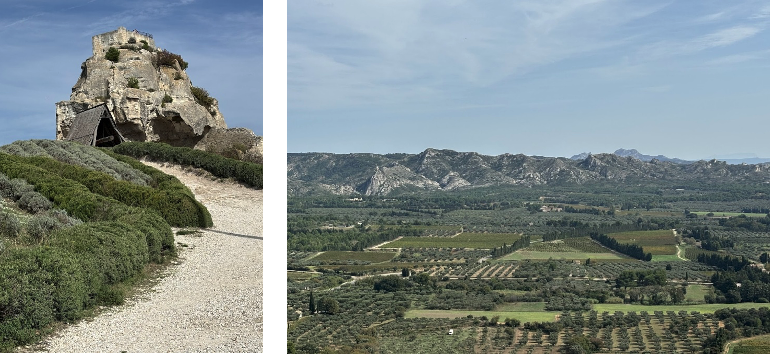QUARRIES IN PROVENCE
Les Carrieres des Luminieres and Roussillon Ochres
Also
MARSEILLE
When we arrive in Provence we start our adventures in Marseille. Walking on La Canabière (street) we head off to the Palais Longchamp. This Palace was built to supply water to Marseille. That took 10 years and 18 aqueducts until completion. The first sight of the palace is the water tower and then the beautiful waterfall. One wing has the Museum of Fine Arts, and the other wing has the Natural History Museum. After ascending the many stairs, we discover behind the walls a lovely network pf gardens once housing a zoo. Also on the estate is an Observatory equipped with the largest telescope in 1864. After leaving Palais Longchamp we stopped for lunch at an interesting seafood restaurant named Le Bôite à Sardine across from Église des Réformes, unfortunately the church was not open for viewing.
The next day we walked north to wander the area called Le Panier, the oldest district of Marseille. We roamed through narrow streets which is like roaming through a colorful art museum of paintings on the outside of the building walls created by the inhabitants. There is also a hospice that was erected in 1745m Vieille Charité. One might even come across some wandering musicians with a following parading behind!
CARRIÈRES DES LUMINIÈRES
We took a road trip to visit the Carrières des Lumimières (Quarries of Lights) These quarries were originally dug into the white limestone to be used in the construction of the Chateau in the village of Baux. Walking into and around a maze of white limestone walls is like a digital museum of moving lighted projection on the many walls of 10 meters (32 feet) wide and 8-9 meters (28 feet) tall, also moving on the floor. The themes change with the seasons. We were there to experience the history of ancient Egypt (L’Egypt des Pharaohs). It was a journey through the early daily life along the Nile River, to the construction of the pyramids, block by block. The show continued through the period of life during the various pharaohs and the Egyptian kings and queens, such as the tomb of Nefertari, all projected on the walls in vivid colors.
We walked a short distance to Les Baux de Provence. It is a hilltop village with lovely restaurants, gift stores, and stores to buy locally made products nestled in along the winding streets of this village. The village was built around the Chateau. We wandered around the gardens, cemetery and over the fields displaying the defenses to protect the chateau, such as the door battering ram. It is quite a trek to reach the top of the castle but worth the fabulous panoramic view of the surroundings. We also entered a small chapel with beautiful brightly colored stained-glass windows. Both the multi-media show on the monumental Carrières des Lumimières and Baux de Provence should be visited the same day.
OCHRE FOOTPATH OF ROUSSILLON
SENTIER DES OCRES
The other quarry that we visited is in the Luberon near the village of Roussillon. The “Sentier des Ocres” is the footpath that winds through the landscape created from the remains of the red, orange and gold colored ochre soil that was quarried. This at one time was covered by the sea. In 1780 it was discovered that the red soil could be made into a non-toxic dye. That dye was used up until the end of World War II when synthetic dyes were created. The Sentier des Ocres is a magical walk enhanced by the flora of pine, oak and chestnut trees in the canopy and the undergrowth of small flowers amongst the heather. While walking, discover the panels describing how this area was created, the chemical analysis, and how it was exploited Also it is worthwhile walking up the street to the hilltop village of Roussillon to enjoy the red tinted walls of the buildings and especially the panoramic views of the Luberon, Mont Vaucluse and the surrounding villages over lunch.







